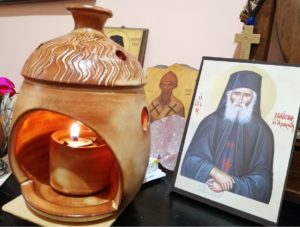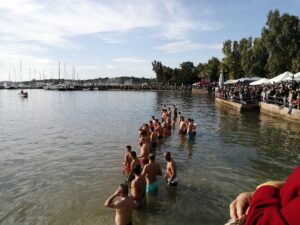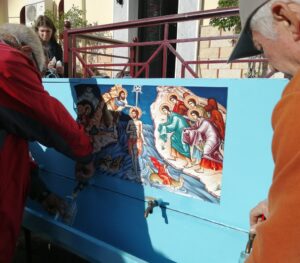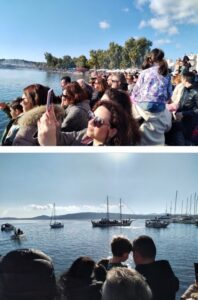Hi, All! Today, I am sharing about the Greek customs of Epiphany, and a little from Italy too.
This is a pic from my little town’s seafront last Saturday, and as you can see it was packed!
Crowds had gathered once again to watch the annual Blessing of the Waters ceremony.
It was Epiphany, you see, January 6, and we were standing near St George’s church, waiting for the mass to finish, as we listened from the speakers.
These brave lads you can see in the photo got in the cold water well beforehand and stood there, I presume to get used to the freezing temperature before it was time to start swimming.
In case you’re not familiar with this Greek custom, I must explain that the Blessing of the Waters takes place in every church all over Greece on Epiphany (‘Theofania’, in Greek).
The mass of the day commemorates the baptism of Jesus in the river Jordan by John the Baptist, who is honoured by the Greek church the next day, January 7.
During mass, when the priest chants about the Holy Spirit appearing in the form of a pigeon during the baptism of Jesus, the priest frees from his hands three pigeons that typically take to the skies at once, circling over the church, as the crowd marvels.
The three pigeons signify the Holy Trinity and the ‘Theofania’ itself, i.e. ‘The appearance of God’, as the full Holy Trinity was present on the day Jesus was baptised. The Holy Spirit showed itself as a pigeon, and God’s voice was heard from the sky too, to declare Jesus as His beloved Son.
In every church around Greece, the priest blesses the water in a tank at the church yard. It usually has little taps on it, and after the ceremony it stays at the church yard for a couple days so that people can come and collect the holy water (Agiasmos) in bottles.
Many Greeks will take this ‘Agiasmos’ home and everyone in the family will drink some, careful not to spill any. They will then keep the remainder in the bottle all year round to be able to drink some when ill or to drizzle around the home when they wish to bless it.
Personally, I go around the house once a year and spill a little on each of four corners of the house, then go outside in the garden and do it again in the four corners of the outside walls. I also sprinkle some holy water on the wheels of my car each time, before a long trip somewhere. As I use the holy water in these instances, I will say a quick prayer to Jesus or to the angels, asking for protection in His name.
Being holy, the ‘Agiasmos’ is not supposed to be thrown in the drain or the trash, but it is okay to sprinkle some in the bowl where animals drink water.
Back to the ceremony of the Blessing of the Waters:
When there is a large body of water near the church, the priest will bless that too. So, in our seaside town, the priest leaves the church ceremoniously after the mass is finished, accompanied by a brass band, and gets on a fishing boat…
By that time, the swimmers are in the sea waiting in the shallows, and there are many other boats in the water, including one of the port police.
The priest gives the signal to the swimmers and throws the cross in the sea. It is usually made of wood so it can float, and is always attached to a string.
The swimmer who gets to the cross first is believed to be blessed all year round.
This year, the lad who got to the cross first to lift it high and cause the crowds to erupt into applause, did so 5th year in a row! Amazing!
GO HERE TO WATCH A SHORT VIDEO OF THE RACE!

Nuh-uh. I wouldn’t like to be a kid in Italy. With the wild imagination that I have, I’d be going mental throughout the Christmas season, never catching a wink he he
This is Befana, the Italian Santa Claus. She doesn’t go ‘Ho ho ho!’ and she arrives riding something much less glorious than a sleigh led by reindeer. This santa rides a broomstick, folks!
Befana comes on the eve of Epiphany to leave candy inside the socks of the good kids. If they’re bad she’ll leave them a lump of coal, or dark candy at best. Sometimes, she may also leave the bad kids onion or garlic. Admittedly, that won’t be tasty at all haha
And what do you know? This witch is very tidy! She will sweep the floor before leaving! This symbolizes a wish for all things bad to be swept away from the home at the start of a new year.
Italian children are taught to leave a glass of wine and a few morsels of food for Befana overnight.

I spent New Year’s in Rome once, and the stalls on the streets were full of Befanas on their broomsticks.
By the way, I wrote a post upon my return, giving my readers a virtual tour of the most beautiful churches of Rome. They kept me awestruck throughout my short stay, and I was oohing and aahhing all day long. Truly, I am still to see a church half as awe-inspiring than the average church in Rome!
GO HERE TO SEE THE POST

Interested in Greek customs and culture? Check out this blog reel where you’ll find a few of my best posts on these subjects. The New Year’s cake with the hidden coin, the plant that brings good luck in the new year, St George and the ‘Red Egg’, Greek memorial food for the dead, the use of vigil lamps and more. Enjoy!
OOPPAAA! SIGN UP TO MY BIMONTHLY NEWSLETTER AND GET 3 BOOKS FROM ME AS A WELCOME GIFT! SEE BELOW FOR THIS OFFER!
YOU KNOW WHAT THEY SAY… SHARING IS CARING! Tweet this to spread some love:
Greek epiphany customs and a scary Santa! #greek #authors #authorslife Share on X
Special offer! Sign up below and get these books for FREE!






